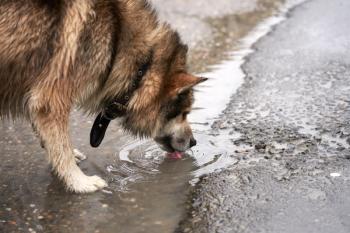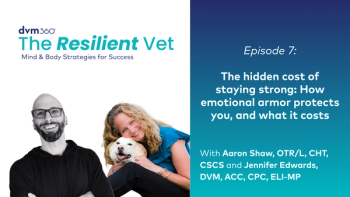
Infectious problems of newborn calves (Proceedings)
While the leading causes of calf illness and death within the first few days after delivery are non-infectious physiological disturbances, after that time, the majority of illness and death losses are attributable to infectious conditions.
While the leading causes of calf illness and death within the first few days after delivery are non-infectious physiological disturbances, after that time, the majority of illness and death losses are attributable to infectious conditions. It is useful to group these infectious conditions based on their underlying pathophysiology, rather than diagnosing them by specific disease agents. Distinguishing between localized viral/protozoal enteritis, bacterial enteritis and septicemia can help focus attention on appropriate sampling for diagnosis, establishment of accurate prognosis, effective treatment measures, and effective preventive practices.
Viral or protozoal enteritis in calves is attributable to organisms that cause superficial damage to the mucosal lining of the intestinal tract. The primary sign of disease is diarrhea (or "scours"), attributable to malabsorption, maldigestion, or hypersecretion. The disease effects and eventual cause of death in affected calves are attributable to the loss of electrolyte-rich body fluids. Without invasion beyond the gastrointestinal mucosa, the organisms involved do not cause significant pathology in other organ systems. The dehydration, depression, weakness, inappetence, and metabolic acidosis that accompany this problem typically occur in direct relation to the severity of the fluid loss. The magnitude of fluid loss and acid-base imbalance and ability of calves to withstand insults are impressive.
The direct cause of calf scours is exposure to and infection by specific infectious agents. Indirect causes include the many factors that increase calf exposure to the microorganisms or decrease calf resistance to infection. The microbes may act individually to cause diarrhea but frequently when a scours outbreak is found in a herd, two or more of these agents can be identified in affected individuals or in the group of scouring calves. Although each of these agents is unique, and they can cause disease in several different ways, the end effect of the infection in the calf is strikingly similar for all of the major scours-causing agents. The four agents that cause the majority of calf scours are rotavirus, coronavirus, cryptosporidia and K-99 E. coli.
The four microbes just described are the leading causes of calf scours but they are not the only causes of diarrhea. An important distinction needs to be made between calf scours and other types of infections that may produce diarrhea but also other organ problems. The prevention, treatment and eventual prognosis of these diseases are quite different. In calf scours, the primary problem is diarrhea. The diarrhea seen in calves with some other infections is only one of many problems caused by the infecting organism and in such cases calves usually die because of damage to other tissues besides the gut. Calf scours primarily affects calves within the first three weeks of life. The more aggressive diseases that affect multiple organ systems can occur early in the calf's life but can and frequently do affect calves older than three weeks of age.
Focal bacterial infection can localize in almost any organ system of the calf, but most typically these problems occur in the gastrointestinal tract or respiratory system. In contrast to superficial localized enteritis, these infections could be characterized as severely inflammatory to the infected tissue. Gastrointestinal infection is most common in the neonate, while respiratory infections are more typical of the calf beyond one month of age. Organisms commonly incriminated in gastrointestinal infection include Clostridia and Salmonella spp. These organisms can not only damage tissue locally but also cause severe systemic inflammatory responses due to toxin release. Appropriate treatment of affected calves includes aggressive antibiotic and anti-inflammatory treatment in addition to supportive fluid therapy. Prognosis even with prompt and aggressive treatment is guarded. Calves affected with clostridial enteritis usually die rapidly before the onset of diarrhea due to the profound effects of exotoxin on the vascular system.
Septicemia occurs when the infectious organism spreads beyond the site of invasion and is carried hematogenously so that multiple organs show inflammatory damage concurrently. The prognosis for septicemia is grave unless it is recognized early and aggressive medical therapy is instituted. Successful treatment must be intensive and usually includes supportive fluid therapy, antibiotics, intravenous plasma, anti-inflammatory agents, and often intranasal oxygen delivery.
The invasive types of E. coli are capable of invading beyond the gastrointestinal tract to cause septicemia (microorganisms in the blood). In this instance, the infectious bacteria can spread to any organ in the body, including lungs, brain tissue, kidneys, and joints and can cause severe damage at these infected sites. The Salmonella species of bacteria have been associated with calf enteritis but like the septicemic E. coli, Salmonella has a strong tendency to spread beyond the gut and cause widespread disease.
Although septicemia is the most severe of the neonatal calf infectious disease problems, it can be difficult to distinguish from other neonatal diseases because its clinical features are variable and nonspecific. These clinical signs include depression, reluctance to nurse, variable body temperature, ileus, diarrhea, increased heart and respiratory rates, generalized weakness, and recumbency. Most of the frequently occurring neonatal disease conditions mentioned above, including the noninfectious problems, can produce similar clinical signs. For this and other reasons, the cause of a calf death loss problem is frequently misdiagnosed. Furthermore, the development of septicemia is often a sequela or a reflection of other problems occurring earlier in the calf's life.
E coli and Salmonella are the most common bacterial isolates from septicemic calves but there are also substantial numbers of gram-positive bacterial infections and noncoliform agents including Pasteurella, Streptococcus, Staphylococcus, and Clostridia. Approximately one-quarter of the calves we have studied were also found to have polymicrobial infection. These findings confirm that appropriate antimicrobial therapy for neonatal calf septicemia must include broad-spectrum coverage effective against both gram-negative and gram-positive organisms.
Because circulating Ig is effective in preventing microorganism invasion, passive Ig transfer is primarily responsible for preventing septicemic bacterial infections. Absorbed immunoglobulin is not nearly as effective at preventing localized enteritis (neonatal calf scours). Agents such as rotavirus, coronavirus, and Cryptosporidia only affect the superficial lining of the gut wall and it appears that circulating Ig has limited efficacy in preventing this type of infection. Numerous studies suggest, however, that the severity of diarrhea in enteric disease of neonatal calves and the ability of affected calves to survive is positively influenced by increased circulating Ig. Although passively acquired Ig cannot prevent all calf diseases, virtually all studies of neonatal calf performance show a positive benefit of high circulating immunoglobulin concentration on neonatal calf health and survival.
Newsletter
From exam room tips to practice management insights, get trusted veterinary news delivered straight to your inbox—subscribe to dvm360.




